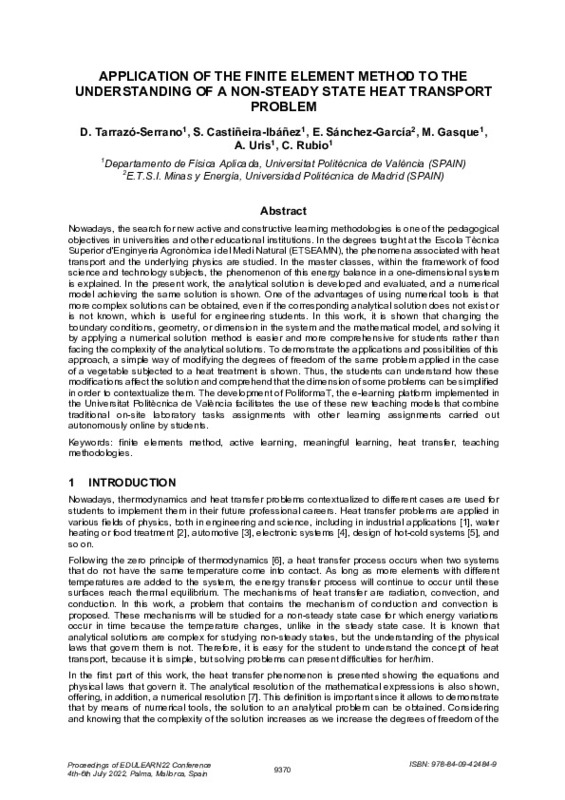JavaScript is disabled for your browser. Some features of this site may not work without it.
Buscar en RiuNet
Listar
Mi cuenta
Estadísticas
Ayuda RiuNet
Admin. UPV
Application of the finite element method to the understanding of a non-steady state heat transport problem
Mostrar el registro sencillo del ítem
Ficheros en el ítem
| dc.contributor.author | Tarrazó-Serrano, Daniel
|
es_ES |
| dc.contributor.author | Castiñeira Ibáñez, Sergio
|
es_ES |
| dc.contributor.author | Sánchez-García, E.
|
es_ES |
| dc.contributor.author | Gasque Albalate, Maria
|
es_ES |
| dc.contributor.author | Uris Martínez, Antonio
|
es_ES |
| dc.contributor.author | Rubio Michavila, Constanza
|
es_ES |
| dc.date.accessioned | 2023-01-13T07:22:23Z | |
| dc.date.available | 2023-01-13T07:22:23Z | |
| dc.date.issued | 2022-07-06 | es_ES |
| dc.identifier.isbn | 978-84-09-42484-9 | es_ES |
| dc.identifier.uri | http://hdl.handle.net/10251/191316 | |
| dc.description.abstract | [EN] Nowadays, the search for new active and constructive learning methodologies is one of the pedagogical objectives in universities and other educational institutions. In the degrees taught at the Escola Tècnica Superior d'Enginyeria Agronòmica i del Medi Natural (ETSEAMN), the phenomena associated with heat transport and the underlying physics are studied. In the master classes, within the framework of food science and technology subjects, the phenomenon of this energy balance in a one-dimensional system is explained. In the present work, the analytical solution is developed and evaluated, and a numerical model achieving the same solution is shown. One of the advantages of using numerical tools is that more complex solutions can be obtained, even if the corresponding analytical solution does not exist or is not known, which is useful for engineering students. In this work, it is shown that changing the boundary conditions, geometry, or dimension in the system and the mathematical model, and solving it by applying a numerical solution method is easier and more comprehensive for students rather than facing the complexity of the analytical solutions. To demonstrate the applications and possibilities of this approach, a simple way of modifying the degrees of freedom of the same problem applied in the case of a vegetable subjected to a heat treatment is shown. Thus, the students can understand how these modifications affect the solution and comprehend that the dimension of some problems can be simplified in order to contextualize them. The development of PoliformaT, the e-learning platform implemented in the Universitat Politècnica de València facilitates the use of these new teaching models that combine traditional on-site laboratory tasks assignments with other learning assignments carried out autonomously online by students. | es_ES |
| dc.description.sponsorship | The authors would like to thank the educational innovation group Multidisciplinary Teaching Innovation Methodology (Teach- Inn) (GIE-64) from Universidad de Las Palmas de Gran Canaria. In addition, we greatly appreciate José Bon Corbín his invaluable support and time. | es_ES |
| dc.language | Inglés | es_ES |
| dc.publisher | IATED | es_ES |
| dc.relation.ispartof | Proceedings 14th annual International Conference on Education and New Learning Technologies (EDULEARN22) | es_ES |
| dc.rights | Reserva de todos los derechos | es_ES |
| dc.subject | Finite elements method | es_ES |
| dc.subject | Active learning | es_ES |
| dc.subject | Meaningful learning | es_ES |
| dc.subject | Heat transfer | es_ES |
| dc.subject | Teaching methodologies | es_ES |
| dc.subject.classification | FISICA APLICADA | es_ES |
| dc.title | Application of the finite element method to the understanding of a non-steady state heat transport problem | es_ES |
| dc.type | Comunicación en congreso | es_ES |
| dc.type | Capítulo de libro | es_ES |
| dc.identifier.doi | 10.21125/edulearn.2022.2262 | es_ES |
| dc.rights.accessRights | Abierto | es_ES |
| dc.contributor.affiliation | Universitat Politècnica de València. Escuela Técnica Superior de Ingenieros de Telecomunicación - Escola Tècnica Superior d'Enginyers de Telecomunicació | es_ES |
| dc.contributor.affiliation | Universitat Politècnica de València. Escuela Técnica Superior de Ingeniería Agronómica y del Medio Natural - Escola Tècnica Superior d'Enginyeria Agronòmica i del Medi Natural | es_ES |
| dc.description.bibliographicCitation | Tarrazó-Serrano, D.; Castiñeira Ibáñez, S.; Sánchez-García, E.; Gasque Albalate, M.; Uris Martínez, A.; Rubio Michavila, C. (2022). Application of the finite element method to the understanding of a non-steady state heat transport problem. IATED. 9370-9377. https://doi.org/10.21125/edulearn.2022.2262 | es_ES |
| dc.description.accrualMethod | S | es_ES |
| dc.relation.conferencename | 14th International Conference on Education and New Learning Technologies (EDULEARN 2022) | es_ES |
| dc.relation.conferencedate | Julio 04-06,2022 | es_ES |
| dc.relation.conferenceplace | Palma de Mallorca, Spain | es_ES |
| dc.relation.publisherversion | https://doi.org/10.21125/edulearn.2022.2262 | es_ES |
| dc.description.upvformatpinicio | 9370 | es_ES |
| dc.description.upvformatpfin | 9377 | es_ES |
| dc.type.version | info:eu-repo/semantics/publishedVersion | es_ES |
| dc.relation.pasarela | S\469374 | es_ES |
| dc.contributor.funder | Universidad de Las Palmas de Gran Canaria | es_ES |








